Greek mythology, the fertile ground that nurtured countless heroic legends and divine figures, has exerted a profound influence for millennia, continuing to ignite human imagination today. Within this vast mythological system, female deities play an indispensable role. Each presiding over different domains, they weave together the glorious tapestry of Mount Olympus with their unique wisdom, power, and charm. The worship and depiction of these Greek goddesses not only gave rise to numerous timeless works of literature and painting but also reached their zenith in sculpture, an ancient art form. These goddess figures, frozen in cold marble or solid bronze, are not merely outstanding testaments to ancient Greek art and craftsmanship but also visual bridges connecting modern people to the ancient mythological world.
This blog aims to give you a comprehensive perspective on Greek goddess sculptures, delving into unprecedented depth and breadth. We will go beyond traditional introductions to analyze the most famous Greek goddesses and their corresponding classic sculptures, tracing their mythological origins and the evolution of their artistic styles. Combining the latest industry insights and user search trends, we will reveal the cultural significance, creation processes, and contemporary value and resonance behind these immortal artworks. Whether for pure appreciation of classical art, finding a meaningful decoration for your space, or exploring the possibility of custom sculpture, this article will offer unique and practical insights, leading you into a world full of myth, art, and beauty.
Famous Greek Goddess Sculptures and Their Myths
This section will provide detailed introductions to goddesses who hold significant positions in Greek mythology and possess iconic sculptures that have survived to this day. By blending mythological stories with artistic analysis, we will present a multi-dimensional and vivid portrait of these goddesses.

Aphrodite / Venus
She is the undisputed goddess of love and beauty in Greek mythology, presiding over pleasure, procreation, and desire. In Roman mythology, she is known as Venus. Aphrodite symbolizes the vigorous vitality of nature and the powerful charm that attracts all things.

Myth and Symbolism
Aphrodite’s birth itself is full of mythical color: one story says she was born from the sea foam produced by the severed genitals of the sky god Uranus falling into the sea; another says she is the daughter of Zeus and the ocean nymph Dione. Her beauty was unparalleled, capable of captivating mortals and even gods. Doves, sparrows, roses, and myrtle are her typical symbols. She is not only the mistress of love, but in some ancient Greek city-states, she was also regarded as the protector of sailors and warriors.
Famous Sculptures Analysis
- Venus de Milo
- Era and Discovery: Approximately 130-100 BCE, created during the Hellenistic period. Discovered in 1820 on the Greek island of Milos.
- Artistic Features: This approximately 2.03-meter-tall sculpture made of Parian marble, with its perfect bodily proportions, elegant S-shaped curve (contrapposto), and arms lost over time, has become a classic interpretation of female bodily beauty in Western art history. Her semi-nude form, soft skin texture, and mysterious expression seemingly containing deep meaning together create a beauty that is both sensual and divine. The missing arms, far from diminishing her charm, have fueled endless imagination and study, making her an eternal symbol of incomplete beauty.
- Current Location: Louvre Museum, Paris, France.
- Aphrodite of Knidos
- Era and Significance: Approximately 360 BCE, created by the Classical period master sculptor Praxiteles. This is the first known life-size female nude sculpture in ancient Western art history, marking a watershed moment. The original is lost, and what we see today are numerous Roman copies.
- Artistic Features: The sculpture depicts Aphrodite at the moment of preparing for or just finishing her bath. Her pose is natural and modest; one hand seems to cover her front or reach for clothing. Praxiteles, with his exquisite skill, conveyed the softness and curves of the female body, establishing a new paradigm for female nude sculpture that profoundly influenced subsequent Hellenistic and Roman art.
- Current Location: Roman copies are dispersed in museums worldwide, such as the Vatican Museums and the Glyptothek in Munich.
Athena / Minerva
Athena is the Greek goddess of wisdom, strategic warfare, handicrafts, and heroic endeavor. She was born fully armed from the head of her father, Zeus, symbolizing the protection of reason, order, and civilization. In Roman mythology, she is known as Minerva. She is the guardian goddess of the great city of Athens, which is named after her.

Myth and Symbolism
Athena is Zeus’s favorite daughter and shares his authority. She represents just war undertaken for defense or protection, not the bloodthirsty conflict represented by Ares. The owl (symbolizing wisdom), the olive tree (her precious gift to Athens), snakes, and the head of Medusa often worn on her breastplate or shield are her symbols. She is an eternally chaste goddess.
Famous Sculptures Analysis
- Athena Parthenos
- Era and Creation: Mid-5th century BCE, created by the greatest ancient Greek sculptor Phidias inside the Parthenon on the Acropolis of Athens. The original stood about 12 meters tall and was made of gold and ivory (chryselephantine sculpture), representing the ultimate expression of the wealth and faith of the Athenian city-state during the Classical period. The original is lost; her image is preserved through written descriptions and small Roman copies.
- Artistic Features: The sculpture depicted Athena standing armed and majestic, wearing an ornate helmet, clad in the Aegis breastplate, holding a statue of Nike (Victory) and a spear, with a serpent coiled beside her shield. Her monumental scale and precious materials highlighted Athens’ power and profound reverence for its guardian goddess. Copies are typically made of marble, attempting to replicate the majestic appearance and symbolic elements of the original.
- Athena in front of the Academy of Athens
- Era and Style: 19th-century Neoclassical period, created by Leonidas Drosis.
- Artistic Features: This marble sculpture, standing on a tall column at the entrance of the Academy of Athens, is a modern tribute to the classical image of Athena. Athena stands tall, holding a spear in her right hand and resting her left hand on a shield bearing the head of Medusa. Her helmet is adorned with a sphinx and an owl. The sculpture’s style is solemn and elegant, perfectly complementing the grandeur of the Neoclassical architecture, symbolizing the eternal value of wisdom and learning.
- Current Location: In front of the Academy of Athens, Athens, Greece.
Artemis / Diana
She is the Greek goddess of the hunt, wilderness, wild animals, and the moon. She is also the protector of young women and chastity. In Roman mythology, she corresponds to Diana. She is the twin sister of Apollo, god of light.
Myth and Symbolism
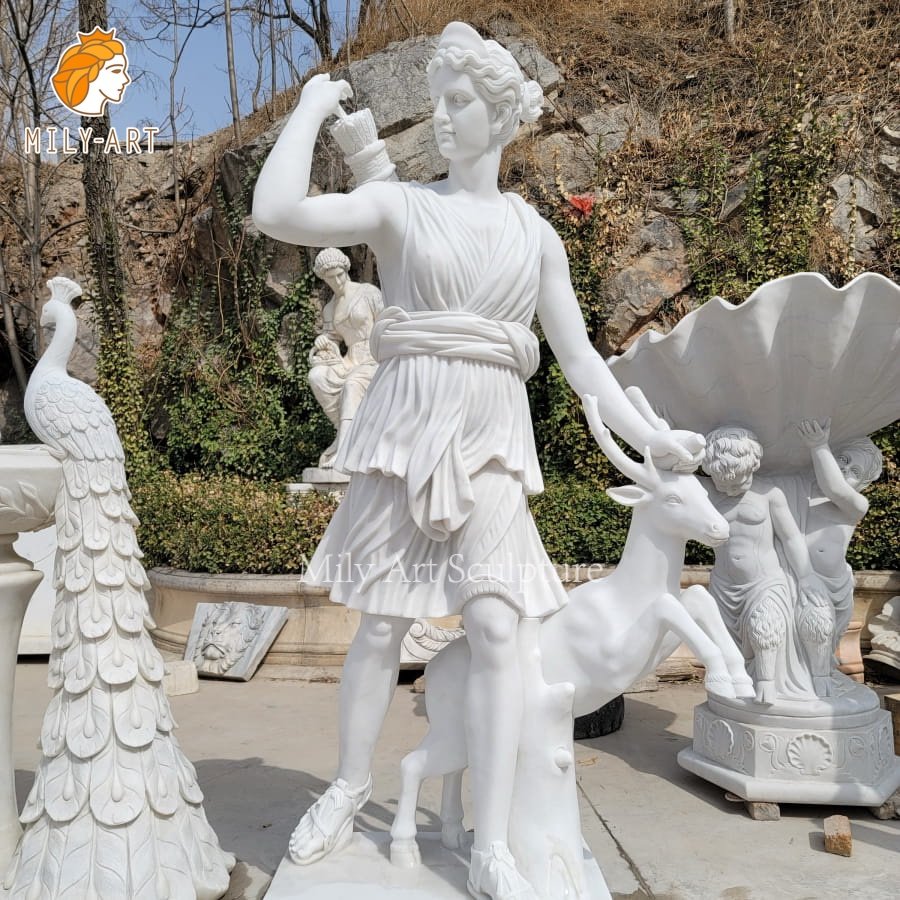
Artemis loves the free and wild life, often hunting in the mountains and forests with her nymphs. She is depicted as a strong, independent, and resolute female figure, holding a bow and arrow, wearing a short tunic, and often accompanied by hunting dogs or a deer. She symbolizes the primal force of nature, female independence, and the steadfast preservation of purity.
Famous Sculptures Analysis
- Diana at Versailles
- Era and Origin: A Roman copy from the 1st or 2nd century CE, believed to originate from a 4th-century BCE Greek bronze original (possibly associated with the sculptor Leochares).
- Artistic Features: This slightly larger-than-life-size marble sculpture depicts Diana wearing a short tunic suitable for movement, in a light pose, seemingly reaching for an arrow from her quiver while moving swiftly, accompanied by a small deer. The sculpture captures the dynamic beauty and vitality of the huntress goddess moving through the forest. Its fluid lines and flowing drapery make it a classic representation of Artemis in motion.
- Current Location: Louvre Museum, Paris, France.
Nike / Victoria
She is the personification of victory in Greek mythology, symbolizing triumph in warfare, success in athletic contests, and glory in various competitions. In Roman mythology, she is known as Victoria.
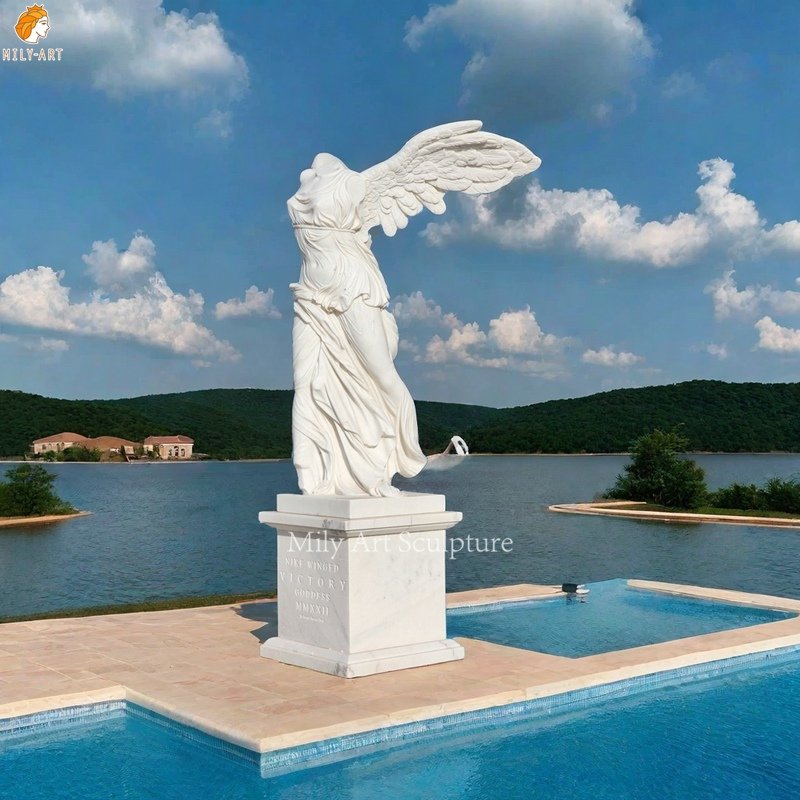
Myth and Symbolism
Nike is often depicted as a winged female figure, capable of swift flight, bringing victory to mortals. She typically holds an olive branch or a laurel wreath, which she bestows upon the victors. She symbolizes speed, strength, and ultimate success and glory.
Famous Sculptures Analysis
- Winged Victory of Samothrace
- Era and Context: Approximately 190 BCE, created during the Hellenistic period, erected in a temple on the island of Samothrace to commemorate a significant naval victory.
- Artistic Features: This imposing marble sculpture was originally placed on a base shaped like the prow of a ship. It depicts the winged goddess of victory as if she has just descended from the sky, standing on the ship’s prow against the sea breeze. Despite the missing head and arms, the sculptor, through expert handling of the goddess’s twisting body, the massive wings, and the drapery clinging tightly and billowing in the wind, imbued the sculpture with unparalleled dynamism and vitality. One can almost feel the sea spray and the powerful force of victory descending. It is a prime example of the dramatic and emotional expression characteristic of Hellenistic sculpture.
- Current Location: Louvre Museum, Paris, France.
Hera / Juno
She is the Greek goddess of marriage, women, childbirth, and family. As Zeus’s sister and principal wife, she is the Queen of Mount Olympus, holding supreme status. Her Roman counterpart is Juno.
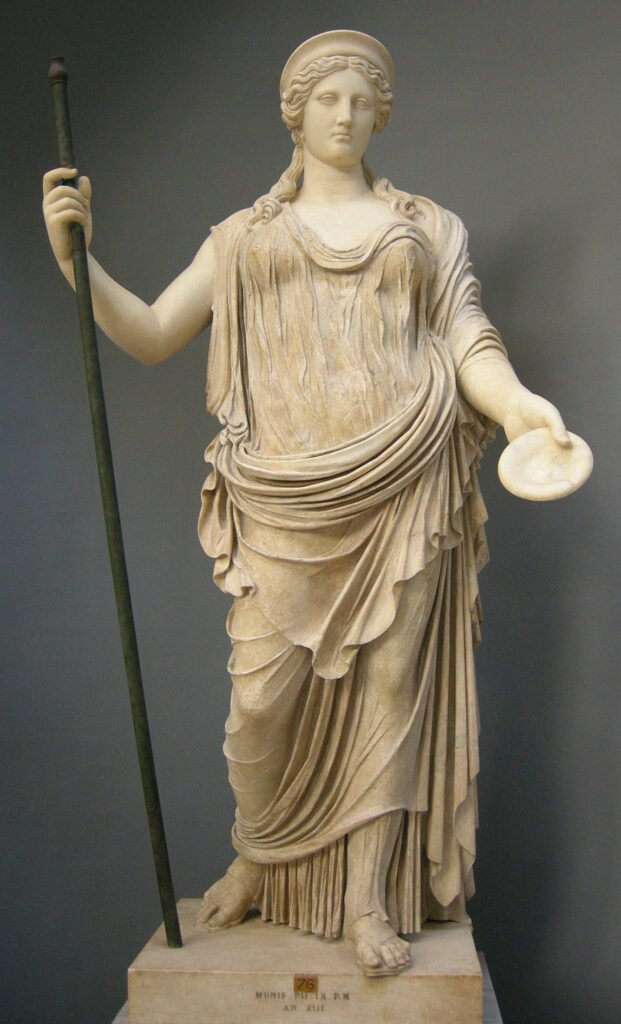
Myth and Symbolism
Hera symbolizes the sacred covenant of marriage and the leading role of women in the home. Her character is complex; she is both a dignified mother goddess and known for her intense jealousy over Zeus’s infidelity and her harsh retaliation against his lovers and illegitimate children. Peacocks, cuckoos, and pomegranates are her symbols.
Famous Sculptural Depictions
Despite Hera’s prominent status, relatively few ancient standalone Hera sculptures of global iconic standing have survived. She appears more often in large temple groups, altar reliefs, or small figurines, typically depicted as a stately, majestic mature woman wearing a diadem. For example, the Hera Borghese in the Louvre is a Roman-era seated statue of Hera. This differs from goddesses like Aphrodite and Athena, who had distinct, dynamic individual divine personalities and widespread secular worship. Hera’s divinity is more embodied in the solemnity and stability she represents as the symbol of the institution of marriage and family.
Demeter / Ceres
She is the Greek goddess presiding over agriculture, grain, harvest, and the fertility of the earth. She is also a symbol of maternal love. In Roman mythology, she is called Ceres.
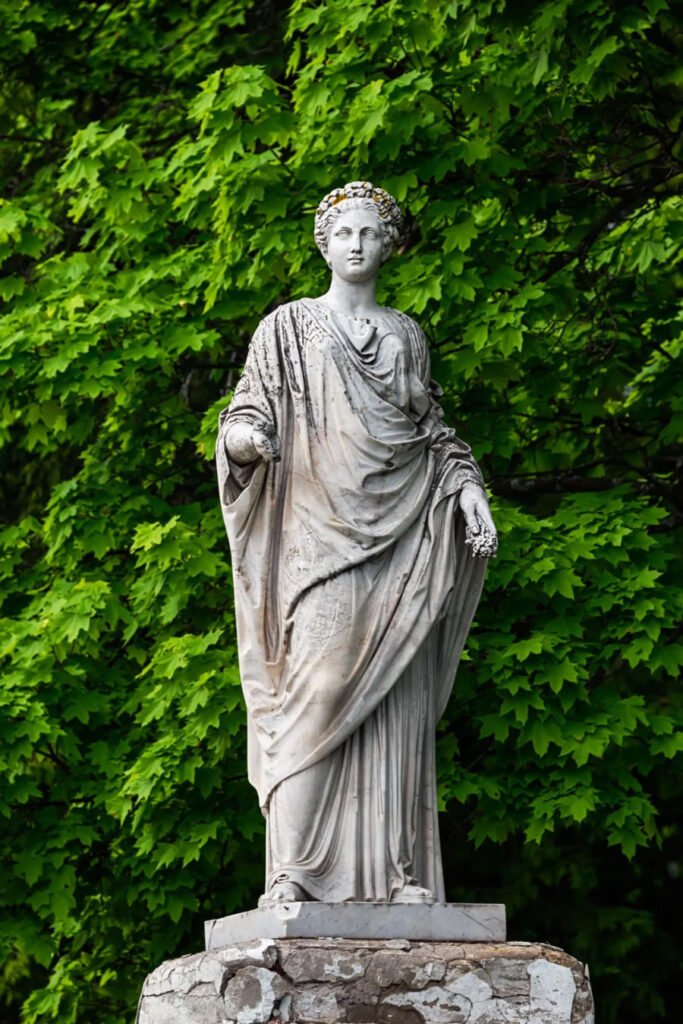
Myth and Symbolism
Demeter’s image is closely tied to the foundation of human survival; she taught humans to cultivate land and ensured crop growth. The story of her daughter Persephone being abducted by Hades, god of the underworld, was used in ancient Greece to explain the changing seasons (especially the dormancy of the earth in winter). She symbolizes the cycle of life, nourishment, and the earth’s generous bounty. Ears of wheat, poppies, and the cornucopia are her symbols.
Famous Sculptures Analysis
- Demeter of Knidos
- Era and Style: A marble seated statue created around 350 BCE, possibly by Praxiteles or his followers. In this sculpture, Demeter is dressed in a long robe and sits in a dignified posture, but her expression conveys a deep sense of melancholy and sorrow, often interpreted as grief over her daughter’s disappearance. This sculpture is renowned for its restrained emotion and exquisite drapery treatment.
Hebe
She is the Greek goddess of youth, the daughter of Zeus and Hera. After Heracles ascended Mount Olympus, she became his wife. Before Ganymede took her place, Hebe was the cupbearer of the gods on Mount Olympus.

Myth and Symbolism
Hebe symbolizes youthful vitality, never-fading beauty, and the freshness of youth. The nectar she poured for the gods allowed them to remain immortal. She represents the innocence of youth and the spirit of service.
Famous Sculptures Analysis
- Hebe Statue
- Era and Style: 19th-century Neoclassical period. Several famous sculptors, such as Bertel Thorvaldsen and Antonio Canova, created representations of Hebe. The works of the Italian sculptor Canova are particularly classic and famous.
- Artistic Features: Canova’s Hebe sculptures (there are multiple versions) typically depict the young and beautiful Hebe, dressed in a lightweight robe, seemingly stepping lightly to pour wine for the gods while holding a pitcher or goblet. The sculptures, with their flowing body lines, exquisite drapery (often employing the “wet drapery” technique to emphasize bodily curves), and lively and sensual poses, perfectly capture the grace and dynamism of the goddess of youth.
- Current Location: Different versions of Canova’s work are held in several world-renowned museums, such as the Neue Pinakothek in Munich, Germany, and the Hermitage Museum in St. Petersburg, Russia.
Hecate / Trivia
She is a powerful and mysterious goddess in Greek mythology associated with magic, witchcraft, the moon, night, ghosts, graveyards, and crossroads. In Roman mythology, she corresponds to Trivia. She sided with Zeus in the Titanomachy and was thus highly respected by him.
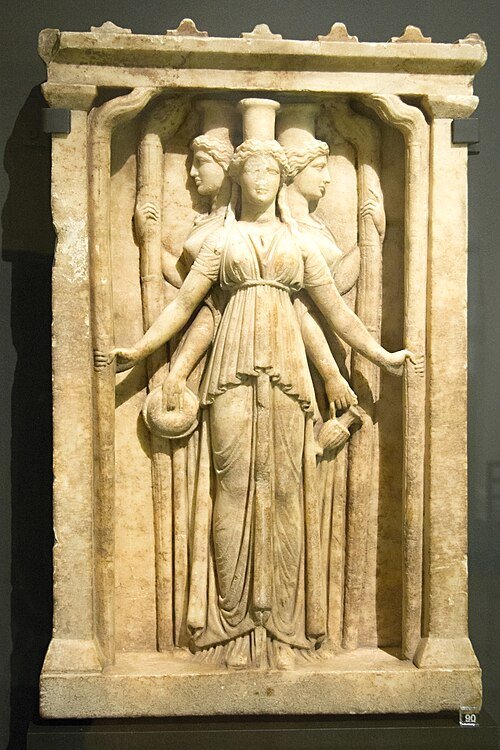
Myth and Symbolism
Hecate is typically depicted in a triple form, or with three faces or bodies. This triple nature may symbolize her control over the realms of sky, earth, and the underworld, or her insight into the past, present, and future. She often holds torches (to illuminate darkness), keys (to open the underworld or the unknown), snakes, or is accompanied by hunting dogs. She symbolizes mysterious power, liminal spaces, and moments of choice and transition.
Famous Sculptural Depictions
In ancient art, Hecate’s image often appears in the form of Hecate Triformis in small votive statues, altars in temples or cemeteries, and on amulets, rather than in large standalone sculptures. These sculptures typically show three female figures standing back-to-back or arranged in a triangle, each facing a different direction, emphasizing her multiple divine aspects and connection to crossroads. This depiction is a unique mark of her divine personality.
Beyond the Classics: The Art and Craft of Greek Goddess Sculpture
Greek goddess sculptures have endured through the ages not only because of the allure of their myths but also due to the ancient Greeks’ exquisite artistic skill and masterful use of materials.
Sculpture Materials and Traditional Techniques
Ancient Greek sculptors primarily used marble and bronze as media, complemented by other materials to create astonishing works.
- Marble: Greece possesses some of the world’s finest marble quarries, notably the Parian marble from the island of Paros, known for its fine grain and translucent quality. This allowed for a perfect rendering of the soft texture of human skin, making it a superior material for sculpture. Sculptors brought life to cold stone through precise cutting, chiseling, and polishing. Many marble sculptures were also painted on the surface for greater realism.
- Bronze: Bronze sculptures were typically cast using the complex lost-wax method. This technique allowed sculptors to create more complex and dynamic poses, and bronze’s strength could support lighter structures without breaking as easily as marble. Bronze surfaces were often polished or treated with patinas to achieve different lusters and textures.
- Chryselephantine sculpture: This technique was used for the most magnificent and sacred sculptures, such as Phidias’s Athena Parthenos and the Statue of Zeus at Olympia. The internal wooden structure of the sculpture was covered with intricately carved ivory panels for the skin parts, while clothing, hair, weapons, and adornments were covered with hammered gold sheets. This technique, combining precious materials, highlighted the sculpture’s exalted status and the city-state’s immense wealth.
Exploring Ancient Workshops: Latest Discoveries on Paros Island
Recent archaeological discoveries (particularly since May 2025) from the Greek island of Paros have provided exciting clues for understanding the production process of ancient Greek sculpture, especially during the Hellenistic period.
- Archaeological Findings: Archaeologists have unearthed a large Hellenistic-era marble sculpture workshop. The site revealed numerous unfinished sculptures at various stages of production, primarily female figures, with a prevalence of semi-finished Aphrodite pieces. Additionally, significant amounts of stone waste, tools, clay models, molds, and traces of pigments used for surface treatment were found.
- Deeper Significance: This discovery confirms that Paros Island was not only a source of high-quality marble but also an important center for sculpture creation and production at the time. The unfinished sculpture samples demonstrate the complex process from rough block to final product, including roughing out, detailed chiseling, polishing, and other steps. The presence of clay models and molds suggests that sculpture production might have already involved a certain degree of standardization or mass production capacity to meet growing market demand and orders. The proximity of the workshop to nearby residential areas (including social spaces) also reflects the important place of artistic creation in ancient Greek daily life.
- Modern Implications: This finding not only deepens our understanding of ancient art history but also provides important technical references and historical basis for modern sculpture replication and customization, proving that even in antiquity, copying popular artworks and producing them on scale already existed.
How to Appreciate and Differentiate Different Goddess Sculptures
Appreciating and differentiating Greek goddess sculptures fundamentally involves mastering their unique iconography – the typical symbols, attire, poses, and accessories associated with each goddess in artworks.
- Aphrodite/Venus: Typically depicted nude or semi-nude, often in an S-shaped pose (contrapposto), representing ultimate female beauty and sensuality. She may be accompanied by Cupid, doves, and hold objects like apples or mirrors.
- Athena: Always shown wearing armor, helmet (often with elaborate decoration), holding a spear and shield (shield often bears the head of Medusa), and often accompanied by an owl or snake. Her image is majestic and rational.
- Artemis/Diana: Wears a short tunic or belted robe for ease of movement, holds a bow and arrows, and is often accompanied by a deer or hunting dogs. Her image is agile and energetic.
- Nike: Having wings is her most prominent feature. She is often shown in a dynamic pose of flying or about to land, wearing flowing robes, and holding a victory wreath or olive branch.
- Hera: Often depicted in a stately, majestic seated or standing pose, wearing a diadem (polos), holding a scepter, possibly with a peacock nearby. Her image is mature and stable.
- Demeter: Typically shown as a mature female figure, wearing a long robe, holding ears of wheat, a sickle, or a torch. Sometimes appears with her daughter Persephone.
- Hebe: Depicted as a young, beautiful maiden, holding a pitcher or goblet for pouring wine for the gods. Her pose is light and lively.
- Hecate: Her most unique image is the triple form, with three faces or bodies combined, often holding symbolic objects like torches, keys, or snakes.
By carefully observing these details, even viewers unfamiliar with specific sculptural works can generally determine the goddess depicted and her corresponding divine domain.
The Modern Echo: Replicas and Customization of Greek Goddess Sculptures
The beauty, artistic value, and profound symbolic meaning of ancient Greek goddess sculptures continue to hold immense appeal in modern society. Whether driven by a pure love for classical art, the desire to infuse living spaces with historical depth and artistic atmosphere, or the search for a meaningful artwork for collection or gifting, the modern demand for owning Greek goddess sculptures continues to grow. This is where the value of high-quality sculpture replicas and personalized customization services lies.
Value and Advantages of Customizing or Replicating Sculptures
- Preservation of Art and Culture: Bringing museum-quality masterpieces into private spaces through high-quality replicas makes classical art accessible, allowing one to experience its charm anytime, anywhere.
- Enhancing Space Aesthetics: Greek goddess sculptures, with their harmonious proportions, elegant forms, and classical style, can significantly elevate the artistic taste and cultural depth of interiors, gardens, courtyards, and even public spaces. They serve as excellent focal points.
- Personal Symbolic Expression: Choosing the sculpture of a specific goddess can serve as a personal reflection or pursuit of qualities such as wisdom, beauty, strength, victory, or motherhood.
- Meeting Specific Needs: Originals are typically fixed in museums, and their size and material cannot be changed. Through customization, clients can create unique artworks that perfectly match their personal vision, adjusting size, environment suitability (indoor or outdoor), preferred materials (natural marble, bronze, resin, etc.), and even fine-tuning sculptural details.
Professional Sculpture Customization Process and Considerations
Choosing an experienced and skilled sculpture supplier is key to achieving high-quality customization. A professional customization process typically includes the following steps:
- Initial Consultation and Needs Assessment: The client outlines the desired goddess, reference prototype, expected size, material, budget, and any special requirements. The supplier provides professional advice.
- Design and Proposal Development: The supplier provides design sketches or 3D models based on client requirements. For complex or highly customized projects, a clay model may be created for the client to review and confirm details.
- Material Selection and Procurement: High-quality raw materials such as natural marble (e.g., Chinese White Marble, Statuario White) or high-grade bronze are selected based on the design. Material quality directly affects the final product’s effect and lifespan.
- Carving/Casting Production: Skilled sculptors carve by hand based on the confirmed design or clay model. For bronze sculptures, the traditional lost-wax method is used for precise casting. This is usually the most time-consuming and skill-intensive stage.
- Detail Refinement and Surface Treatment: After completing the main structure, detailed polishing and texture carving are performed. Surface effects like polishing, aging, patination, or coloring are applied according to requirements.
- Quality Inspection and Client Acceptance: The supplier conducts strict quality checks on the finished product. Clients may review via photos, videos, or in person to ensure all requirements are met.
- Secure Packaging and Shipping: Sculptures typically require professionally customized wooden crates for reinforced packaging to prevent damage during transport. Experienced international logistics partners are chosen to ensure the sculpture arrives safely at its destination.
Important Considerations: The cost of a customized sculpture is influenced by multiple factors, including size, complexity (amount of detail, pose difficulty), type and quality of material (e.g., using top-grade natural Chinese White Marble or Statuario White is more costly), carving detail level, and the supplier. Therefore, thorough communication with the supplier and obtaining a detailed quote are crucial before initiating customization.
How to Choose a Reliable Sculpture Supplier?
To ensure you receive a satisfactory Greek goddess sculpture, choosing the right supplier is essential:
- Rich Industry Experience: Research the supplier’s history and experience in sculpture design, production, and international trade, especially their expertise in classical sculpture replication and customization.
- Excellent Craftsmanship: Determine if the supplier has a team of experienced sculptors who preserve traditional techniques, particularly artisans skilled in hand-carved marble and bronze lost-wax casting.
- Material Quality and Source: Confirm that the supplier can provide high-quality natural stone and metal materials and can state their source to ensure the sculpture’s durability and artistic value.
- Strong Customization Capability: Evaluate if the supplier can understand and fulfill your personalized requirements, from size and pose adjustments to details and surface treatment.
- Good Customer Reputation and Case Studies: Check reviews from other clients and the supplier’s completed projects to assess their actual delivery capability and service level.
- Comprehensive Service System: A professional supplier should offer end-to-end service, including initial consultation, design proposal communication, production progress updates, strict quality control, professional packaging and shipping solutions, and necessary after-sales support.
As you know, MilyStatue, with years of professional experience as a sculpture manufacturer and supplier, understands how to combine the essence of classical art with modern customization needs. We have experienced master sculptors and a strict quality control process. We are dedicated to creating high-quality Greek goddess sculpture replicas and custom works for you, turning your longing for classical beauty into a tangible reality.
Frequently Asked Questions (FAQ)
What are the most famous Greek goddess sculptures?
- Venus de Milo: Symbolizes love and beauty.
- Winged Victory of Samothrace: Symbolizes victory.
- Athena Parthenos: Symbolizes wisdom and strategic warfare.
- Diana at Versailles: Symbolizes hunting and wilderness.
Additionally, the “Aphrodite of Knidos,” “Demeter of Knidos,” and Canova’s “Hebe,” among others, are also highly renowned.
What do Greek goddess sculptures typically symbolize?
These sculptures represent the domains presided over by the goddesses in mythology, as well as the virtues and powers the ancient Greeks attributed to them. They symbolize different concepts such as love, beauty, wisdom, strategic warfare, hunting, victory, youth, fertility, magic, etc., while also reflecting the ancient Greek understanding and worship of the idealized human form, divinity, and natural forces.
How to distinguish between Greek and Roman sculptures?
Although Roman sculpture was heavily influenced by Greek art and often copied Greek originals, stylistic differences exist. Greek sculpture (especially during the Classical and Hellenistic periods) favored idealization, pursuing perfect human proportions and dynamism, expressing divinity or universal human emotions. Roman sculpture, on the other hand, focused more on realism and the depiction of individual characteristics, often used to represent real people like emperors and citizens, and had a more narrative and practical function (e.g., portrait sculptures and historical reliefs). Roman copies sometimes differ from Greek originals in details or proportions.
How much does it cost to customize a Greek goddess marble sculpture?
The price is highly dependent on the sculpture’s size, complexity (amount of detail, difficulty of pose), type and quality of marble (e.g., using top-grade natural Chinese White Marble or Statuario White is more costly), level of carving detail, and the supplier. Small sculptures may range from hundreds to a few thousand dollars, while life-size or larger, highly customized, and detailed sculptures can cost anywhere from several thousand to tens of thousands or even hundreds of thousands of dollars. Obtaining a detailed quote requires communicating specific requirements with the supplier.
Where can I buy or customize Greek goddess sculpture replicas?
You can choose professional art sculpture factories, experienced sculpture studios, or reputable online art platforms. Look for suppliers who specialize in stone or bronze sculptures and clearly offer customization services, capable of showcasing numerous past cases and client reviews. Working directly with a factory can often provide more flexible customization and more competitive pricing.
Who are the main goddesses in Greek mythology?
Among the Twelve Olympians, there are six main goddesses: Hera (marriage), Demeter (agriculture), Hestia (hearth, sometimes replaced by Dionysus), Aphrodite (love and beauty), Athena (wisdom and war), and Artemis (hunting and moon). Furthermore, within the broader mythological system, Nike (victory), Hebe (youth), Hecate (magic), and Persephone (Queen of the Underworld), among others, are also important goddesses.
Conclusion
Greek goddess sculptures, these artistic masterpieces spanning millennia, continue to captivate the world with their unique charm and profound meaning. They are not merely historical relics but living storytellers of myth, eternal symbols of art and beauty. From Venus’s graceful pose to Athena’s majestic gaze and Nike’s dynamic flight, each sculpture embodies the wisdom and emotion of ancient Greek civilization.
By exploring these sculptures, we can not only gain a deeper understanding of ancient Greek mythology, history, and art but also feel humanity’s relentless pursuit of beauty and ideals. If you are moved by these immortal artworks and wish to bring this classical elegance and profound symbolic meaning into your living space, whether by choosing a classic replica or customizing according to your unique vision, professional sculpture manufacturers can help you achieve this wish.
MilyStatue, with its decades of deep expertise in the sculpture field, combining exquisite traditional craftsmanship with modern technology, and a commitment to high-quality natural materials, is dedicated to providing you with world-class Greek goddess sculpture customization and replica services. We understand that each sculpture carries a unique meaning and look forward to collaborating with you to bring your perfect image of a Greek goddess to life, infusing your space with eternal mythological beauty.


